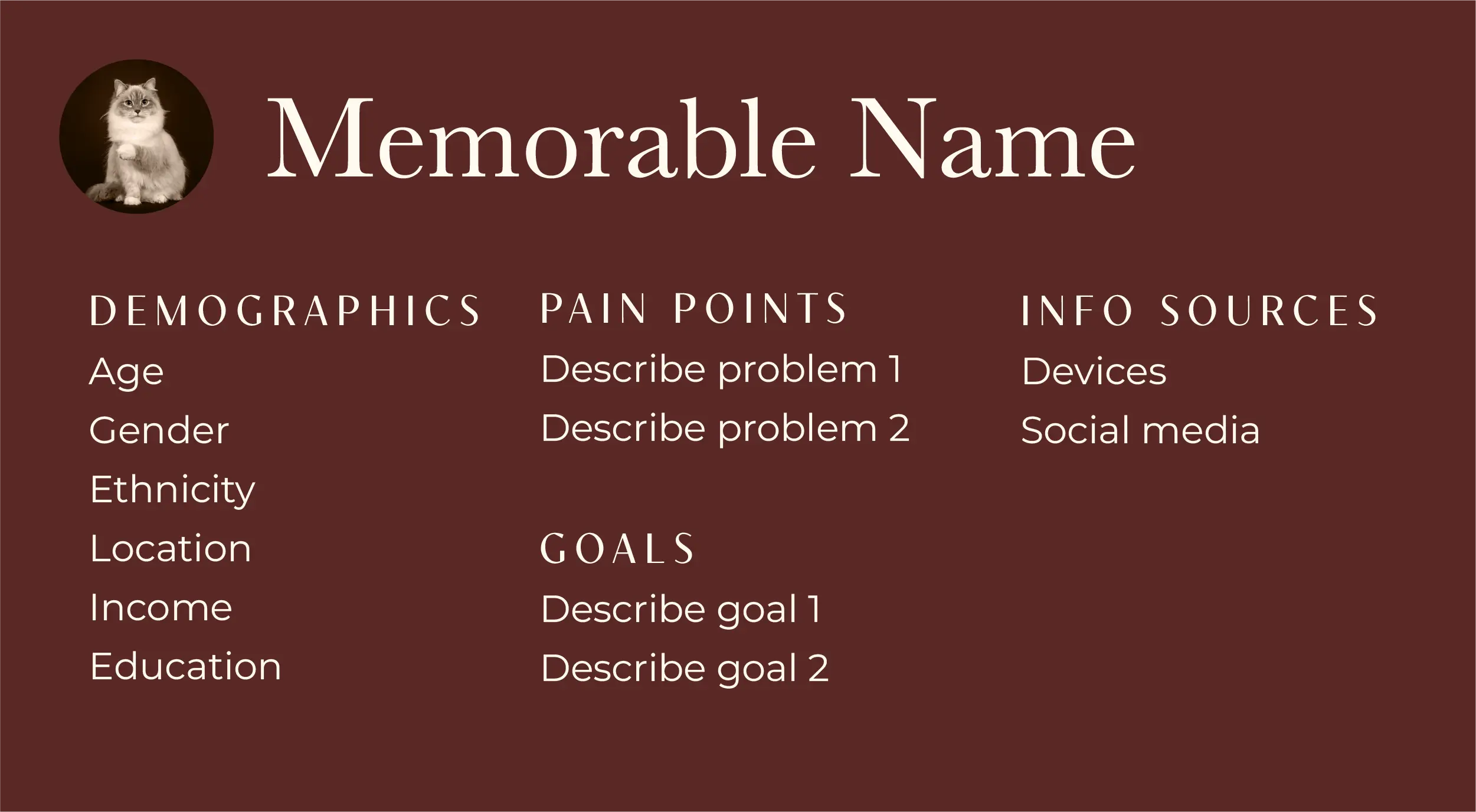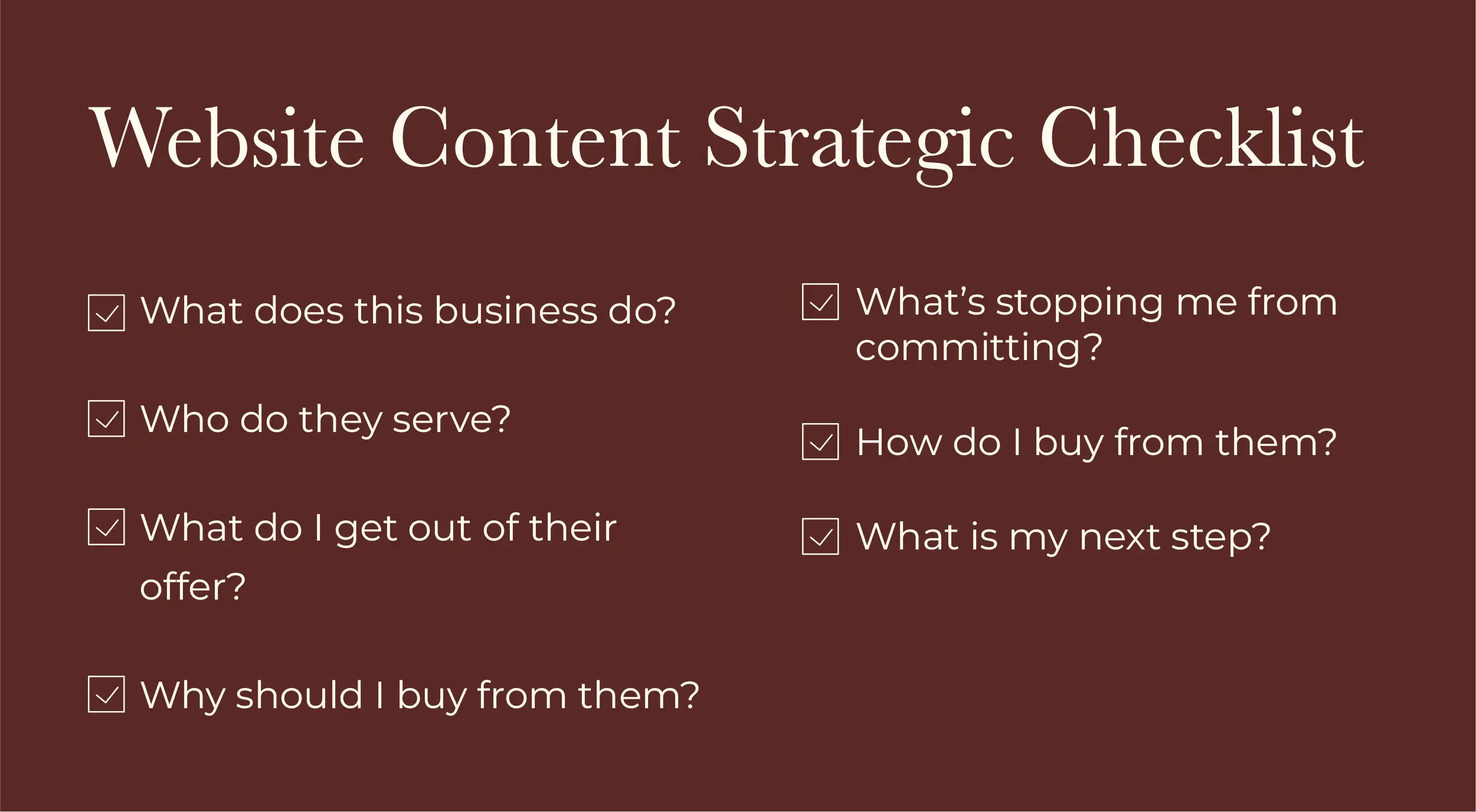A website doesn't do much good if no one visits it, but getting clicks is hard work. It takes time, money, or both to gain traction. Advertisements can bring you a lot of views quickly, but if your targeting is wrong, that's wasted money. Content marketing, which is my primary strategy, takes months to yield results. Referrals are ideal, but outside of your control.
You must make a significant effort to attract people to your website. But once people click, what happens next? Is your website working for you, or is it merely checking off a box on your to-do list?
A good website knows its job and executes on its purpose. For small businesses, that purpose is to sell goods and services. For e-commerce websites, that means selling products. For service-based businesses, this often means collecting inquiries and leads.
A bad website lacks clarity. If people can't tell what you offer right away, or the website confuses them, they'll leave without buying. A lot can go wrong with a website, which is why I've written about 9 website mistakes that can damage a business. Anyone can put some images and text on a page and call it a website. But if you don't know what to look out for you could fall into one of those pitfalls.
Jump to a section
Use these links to skip ahead to any section:
- Websites: the salesperson who never sleeps
- Know your customer: unlock the power of personas
- Build with persuasion: high-converting landing page elements
- Effective copywriting frameworks: your roadmap to success
- Is artificial intelligence (AI) hurting your brand's reputation?
- Why poor content costs conversions
- Does your website convert leads into customers? Your strategic checklist
Websites: the salesperson who never sleeps
If you only think of your website as an online listing, it'll never live up to its full potential. Don't reduce it down to a digital version of the Yellow Pages. This isn't the 1980s, and all your copy isn't printed and confined to a small box.
Instead, think of your website as an employee who never eats, sleeps, or takes time off. While you are off doing other things, your website is:
- providing information and answering prospective clients' questions,
- establishing your credibility and expertise in your field, and even
- convincing people to open their wallets to give you their money.
Take that, Yellow Pages—Internet: 1, phone books: 0.
None of this happens on its own; you have to be intentional and strategic. First, you need to know your audience. Then, you need to guide them down your sales funnel. This takes a lot of effort and trial and error to learn what works. Get it right and you'll reap the benefits of inbound marketing.
Keep one thing in mind: you can't sell to everyone. If you try to appeal to everyone, you won't attract anyone. Identify your ideal customer, then focus on meeting their specific needs. You will alienate some people, but you can also build a community of true believers. The latter group is so much more important than people who were unlikely to ever buy from you in the first place.
Know your customer: unlock the power of personas
Alright, you know that your website can be a powerful tool if you set it up right, but how do you do that? Start with market research, then create personas.
For a new business, you don't have an existing customer base to tap into, so you'll need to be resourceful and creative. There's a lot of free information on the Internet if you take the time to dig for it. In early 2025, for my market research, I looked at:
- data from federal and state governments,
- reports from research organizations, and
- discussions on online forums such as Reddit.
If your business is already established, survey your existing customers. You'll gain insights into why they chose you that you can leverage to convince other people to buy as well. You should also ask for ways you can improve; that feedback may be even more valuable.
Once you have data on your ideal customers, analyze it and create personas. A persona is a fictitious person representing a group of real people. Make your personas as realistic as possible, so that they feel like actual people. Personas often include:
- a memorable name,
- demographics,
- goals,
- pain points, and
- the methods they use to get information.
I plan to cover personas more in the future.

Creating personas is a lot of work, but I promise it pays off. You don't need many; 3 is ideal. If you make too many personas, your messaging will suffer.
Personas are powerful tools because they help you unlock empathy. Humans tend to be egocentric. We all struggle to understand others' perspectives at times. A persona enables you to imagine yourself as someone else. It puts you in their shoes.
Reflect on your personas often and use them as a benchmark. Ask yourself, "What problem is Jamaal facing?" and then figure out how you can help him solve it. This framing will strengthen your message. You'll focus on your customers' needs, rather than your desires. All your marketing channels will benefit, including your website.
Your website should help your personas achieve their goals. If Jesse's basement floods, they need to find your phone number as soon as possible to get that leak fixed. If Rebecca and Lauren need to plan for retirement, they don't want a scammy life insurance policy. They want to be confident that you'll put their best interests first.
Your website should provide solutions to real people's problems. If it does, your services will sell themselves.
Build with persuasion: high-converting landing page elements
At this point, you've done market research, created personas, and identified problems. Now, you need to put it all together into an effective landing page and/or website. In this section, I'll cover the general structure about what your website needs to do.
Unfortunately, there isn't an easy formula for the perfect page layout. You'll need to experiment to learn what works best for your offer and audience. That said, most successful landing pages share common elements, such as:
- Hero: A page's top section that's visible before you scroll down the page. Sometimes referred to as "above the fold."
- Service or product descriptions: Use clear and concise language to explain what you do. Use your audience's vocabulary, not your industry's jargon.
- Benefits and features: What benefits will people gain from your offer, and how is that possible?
- Problem: Why does someone need your offer? What is causing them pain that only you can solve?
- Solution: Your offer remedies their problem.
- Transformation: How is their life better or different after purchasing from you?
- Unique selling point (USP): Why they should buy from you and not the other guy. What sets you apart from your competition?
- Social proof: Prove your legitimacy and reduce risk through reviews, ratings, and testimonials.
- Evidence of authority: Establish yourself as capable and competent to solve their problem.
- How it works: Explain the process and steps involved to go from the status quo to your transformation.
- Prices: The cost of your offer.
- Frequently asked questions: Address their main objections and remove lingering doubts and friction.
- Call to action (CTA): What you want them to do next.
Not all elements appear on every landing page, but pages that convert use several. These aren't strict sections; in fact, you should combine some within the same section. For example, in 56 words, Neva Masquerade's hero:
- identifies who we serve (small business owners);
- states a problem (website not working hard enough, finding time and budget for web design feels overwhelming);
- offers a solution (personalized touch that sets your brand apart);
- shows a transformation (elevate your brand, grow your business); and
- includes a primary CTA (book a call) and a secondary CTA (how it works).
On the rest of the homepage, you'll find sections devoted to many of these elements. You'll also see the primary CTA repeated in most sections.

Additionally, ensure your landing page and website are usable. If people can't use your website and tell what you do or how to contact you, they may leave and go to your competition.
This is especially true for mobile users. Search Engine Watch reported that 80% of mobile searches end in a sale, often within a few hours.
If your mobile website sucks, people may return to the search results and check out the next business. I cover this topic extensively in "Mobile-First Matters: Optimize Your Website to Rank Higher and Sell More."
Effective copywriting frameworks: your roadmap to success
A well-designed and clear layout is essential. If your website doesn't communicate what you do or how to reach you, it has failed to do its job. Design without communication isn't design—it's art.
To get conversions, you need to marry the aesthetics (design) with the copy (content). How do you do this? Follow these battle-tested copywriting frameworks.
Storytelling
The world's most successful brands tell stories. Nike inspires you to overcome obstacles and "Just do it." Apple invites you to challenge the status quo with "Think different." Patagonia empowers you to fight against consumerism by telling you, "Don't buy this jacket."
These brands are memorable and iconic. It isn't because of their products, though—it's for the transformation they offer. The company isn't the hero of the story; the customer is. You triumph. You break out of the mold. You save our planet.
The good news is that you don't need millions of dollars to tell a story. You only need to identify the characters and plot points. Joseph Campbell's hero's journey includes 12 steps, but Donald Miller condensed it down to 7 for brands:
- A character (your customer)
- Has a problem (their struggles)
- They meet a guide (your brand)
- Who gives them a plan (the steps to get your solution)
- And calls them to action (your CTAs)
- They succeed (they buy your offer) or fail (they don't buy it)
- And transform (from struggling to successful).
You may notice that many of these steps correlate to your landing page's main elements. This isn't a coincidence—persuasive copy tells a story. And yes, I did use this approach for Neva Masquerade.
Refer to your personas while crafting your brand's story; remember they're the hero, not you.
PAS (Problem-Agitate-Solution)
This popular framework reminds (or enlightens) your reader that they have a problem. Once they're aware of it, you pour salt in the wound to make them feel the pain and want an immediate remedy. At this point, your reader is ready to hear your offer—they have a problem and they want it fixed, now. You can now explain how you can ease their pain.
PAS is effective because it prods the buyer into action. People can be prone to entropy—objects at rest tend to stay at rest. Sure, that pesky problem is annoying, but meh, it's not worth the effort to change anything. PAS makes them realize that they are the frog in a pot of water that's starting to boil. It is a serious problem, and they must take action now.
AIDA (Attention-Interest-Desire-Action)
A classic marketing technique, AIDA is particularly relevant for social media content.
First, you hook the reader's attention with something like:
- an eye-catching graphic,
- a bold claim, or
- a controversial question.
Next, you have to hold their attention and convince them that what you have to say is relevant to them. You do this by addressing a need, a problem, or piquing their curiosity.
Now that they're invested, transition their intellectual interest into an emotional want. Share your solution's benefits, their transformation and success, or how they'll fail without you. You can also use exclusivity or scarcity tactics to intensify the pressure further.
Finally, please provide them with a simple next step to take. Don't leave them guessing and don't make them think. Make it easy for them to take the next step towards conversion.
Other frameworks
Copywriters use many other frameworks in their writing. If you'd like to explore this topic further, I recommend learning about:
- BAB (Before, After, Bridge): Describe their current problem, suggest how your solution will improve their life, and explain how you can get them from A to B.
- The 4 Ps (Picture, Promise, Prove, Push): Have them picture success, make a promise to achieve it, prove you're legitimate, and push them to take action.
- FAB (Features, Advantages, Benefits): Explain what you do, how your offer is better than others, and how it will help them.
- The 4 Cs (Clear, Concise, Compelling, Credible): Use this checklist to keep your writing clear, short, persuasive, and believable.
Marketers use these seven frameworks because they are effective. Now that you know about them, pay attention and see if you can spot them in the wild!
Is artificial intelligence (AI) hurting your brand's reputation?
Putting everything together will take a lot of work. If you do this around your other responsibilities, plan to spend weeks on it. Persuasive and compelling content takes time and many revisions.
Are you thinking about asking ChatGPT or another AI to do this work for you? After all, AI can generate all your content in a matter of minutes.
Resist this urge.
AI can be a powerful tool. It can automate and speed up various tasks. It can help generate ideas. It can process more information than a human ever could. Love it or hate it, AI isn't going anywhere.
With that said, do not rely on AI to generate all your sales copy. It's a tempting shortcut for sure, but be cautious.
In December 2024, NielsenIQ released a study on consumer perceptions of AI-generated ads. They found that people intuitively identified most of the AI-generated content as such. Many people can recognize AI content without much thought. They also concluded that :
- Negative impressions of AI ads (annoying, boring, confusing) transfer to the brand.
- Gen AI ads are less memorable and likely less effective at inspiring action.
- Gen AI reinforced brand associations, but also connected the brand to negative impressions.
- Low-quality Gen AI images are distracting and hard to understand.
This is just one study on evolving technology, but it's essential to be mindful of how you use it.
Can you ever use AI? Absolutely! Here's how I use it:
- brainstorming ideas for content,
- working through coding challenges,
- proofreading my writing, and
- researching topics quickly.
I don't accept AI outputs without thought; it's not foolproof. I've received many incomplete or inaccurate responses. If I use it for copy, I edit it to make it my voice. I don't use AI to generate content—I use it as an assistant to check and improve my work.
Why poor content costs conversions
Whether a human or AI writes your content, it needs to persuade people and bring them closer to buying. If it doesn't do that, it's failing.
Weak web content costs you opportunities.
Imagine spending $10,000 on ads and getting 0 sales. This can happen if you're directing people to an ineffective or unconvincing page. You got a click, so that lead was at least somewhat interested in you. Tragically, your website couldn't convince them to stay and convert.
At the same time, your competitor has designed their website for conversions. They use psychology, sales funnels, and copywriting frameworks. They guide people from learning about them to making a sale. You're struggling to pay your bills, while they're selling at full capacity.
Why are they successful when you aren't? They took the time to understand their audience and craft messaging that resonates with them. This isn't an accident. It's intentional, and it takes hard work.
Here's how I approach websites and copywriting:
- Get to know the business and its services.
- Learn about its customers.
- Create a brand narrative.
- Write the copy for the website.
- Design and code the website to fit the copy.
- Edit the copy again once it's in place on the website.
Design and content are inseparable. You can't have one without the other. It's best to design around content to keep your messaging strong. Otherwise, you may need to butcher your content to make it fit the layout.
Does your website convert leads into customers? Your strategic checklist

You've almost made it to the end. We've covered a lot:
- How your website works for you 24/7;
- How market research and personas form a solid foundation;
- What elements successful landing pages need;
- What copywriting frameworks you should use;
- Why you should be wary of AI; and
- Why you need a compelling website to succeed.
Whew! Now, you may be wondering where to start. Pretend that you don't know anything about your business. Look at your website and ask yourself these questions:
- What does this business do?
- Who do they serve?
- What do I get out of their offer?
- Why should I buy from them?
- What's stopping me from committing?
- How do I buy from them?
- What is my next step?
How did you do? If you struggled with any of these questions, your copy needs work. Now you know what to focus on, so get writing!
Do you feel overwhelmed or like you don't have the time? I offer copywriting, brand narrative development, and consulting services. You can book a complimentary call to discuss your needs and how I can assist you. If we're a good match, I can save you hours of staring at a computer.


